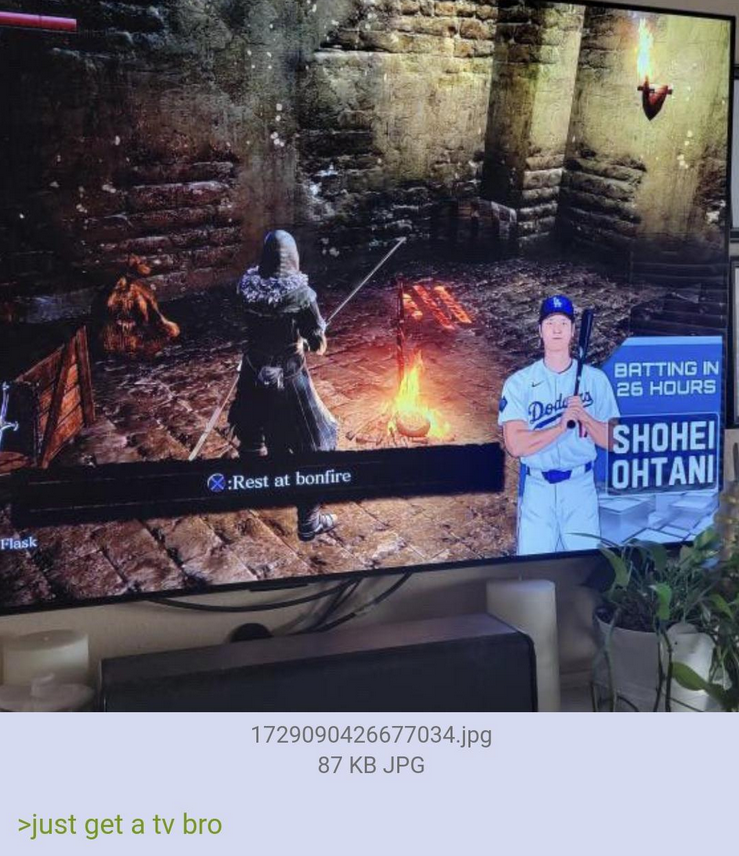this post was submitted on 08 Jan 2025
737 points (99.1% liked)
Greentext
7390 readers
833 users here now
This is a place to share greentexts and witness the confounding life of Anon. If you're new to the Greentext community, think of it as a sort of zoo with Anon as the main attraction.
Be warned:
- Anon is often crazy.
- Anon is often depressed.
- Anon frequently shares thoughts that are immature, offensive, or incomprehensible.
If you find yourself getting angry (or god forbid, agreeing) with something Anon has said, you might be doing it wrong.
founded 2 years ago
MODERATORS
you are viewing a single comment's thread
view the rest of the comments
view the rest of the comments

Connecting a Raspberry pi or a Linux computer into the HDMI port. And not connecting the TV to WiFi.
Smart TV's can be used as dumb TV's by not connecting them to the internet. Likewise the HDMI port can connect your own device for the smart functionality.
Depends on the TV. Some can't be used unless internet connected. Roku TVs are especially bad about this
My two TCL Roku TVs work without an Internet connection. This isn't in defense of Roku TVs to be clear- I regret my purchase, but at least for now they do work offline.
Yeah but is there an OS or a Linux distro specifically geared for use with a "surrogate SmartTV"?
It could also be used by connecting the device to a large monitor, as those are cheaper than SmartTVs. No point paying a premium for features you don't intend to use.
On a related point, what would you do for a remote control in such a setup?
Yea I always hear people say just hook up a PC or Pi but I don't want a keyboard and mouse in my livingroom. The value of these Apple TV / Roku / Google TV setups is you have a little remote and a UI that is designed around it with big visual elements you can see across the room. I'm surprised there seems to be so little movement on something like this.
I guess one issue is apps. The likes of Netflix wouldn't support it.
"I don't want to use a keyboard," was what my wife said at first too. Then she realized that saving hundred of dollars and never seeing another advertisement was worth it.
I used to have the PC setup. Ended up going for an Apple TV 4k. Yea it was $200 but it was a one time purchase 7 years ago and there's no ads. Just serve up everything though Plex and Infuse
Apple TV still has a ton of privacy concerns and most people who are against having to use a keyboard probably aren't going to be setting up a Plex server.
I've been trying to solve this problem for a while. I've not yet found a really good solution, but I can summarize what I've learned, partly for your information but mostly in the hope that Cunningham's law will finally put me out of my misery. Here are suggestions I've seen, organized roughly along some axis of easiest/most popular to hardest/least popular:
As for remotes, there are some decent options on Amazon that connect via bluetooth or a USB dongle and basically act like a mouse and/or keyboard packaged in a remote control form factor. I bought this one a while ago and it's been fine. Nothing special, but fine. The play/pause/volume buttons on the front read on the receiving end like the media buttons on a keyboard. The air-mouse functionality isn't for everyone, but this model is one of the few with a little track pad on the back if you prefer using that. Honestly just get anything with a full keyboard. So much easier than using the arrow keys to click-click-click your way through an onscreen keyboard.
LineageOS Android TV looks like an interesting solution but having SELinux in permissive mode is a bit scary. Maybe someone with more in-depth Linux knowledge can chime in here but my understanding is that would mean that the Android kernel's security system would basically be turned off. Permissive Mode logs security access violations within the OS but does nothing to prevent them so I would be wary of connecting it to the internet.
Yes, im aware of those ways. I remember reading that there was a replacement that was specifically emulating the look and feel of Google TV, but simpler and better. You could install it on Chromecast etc.